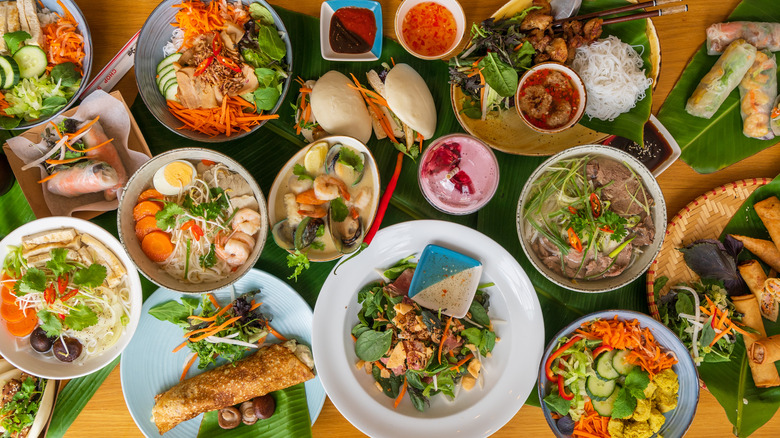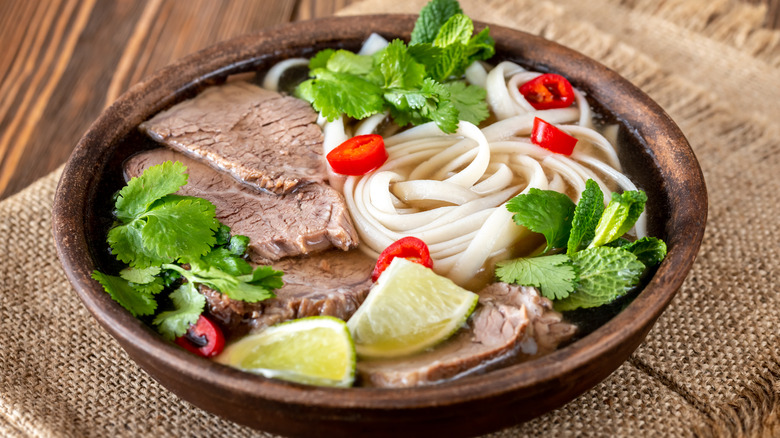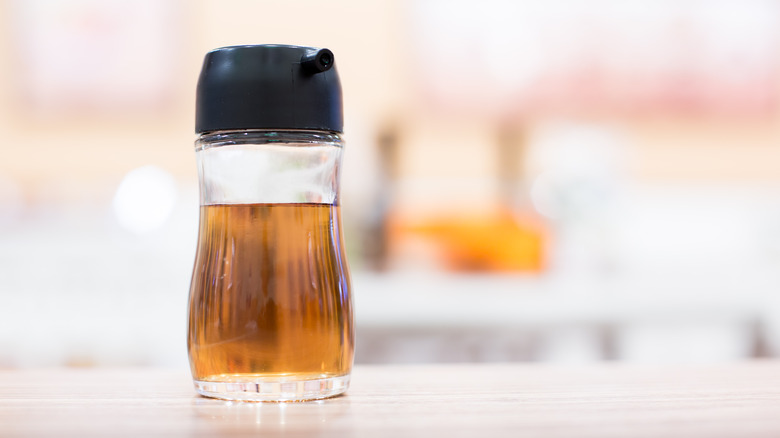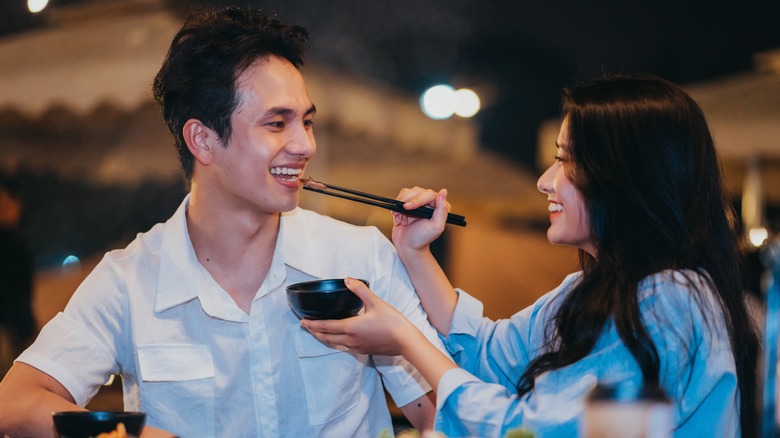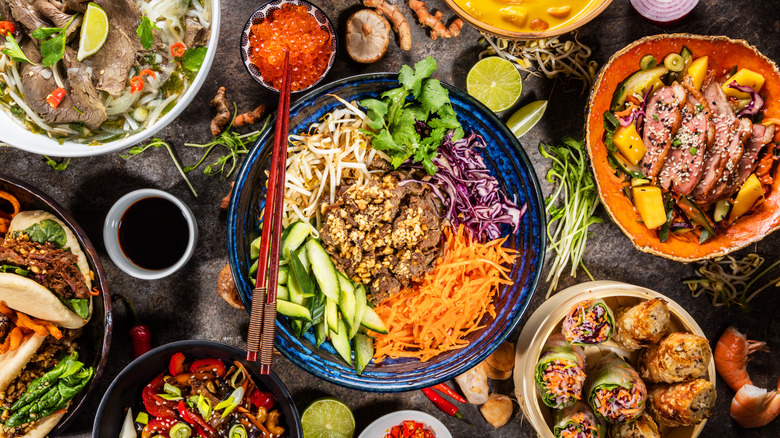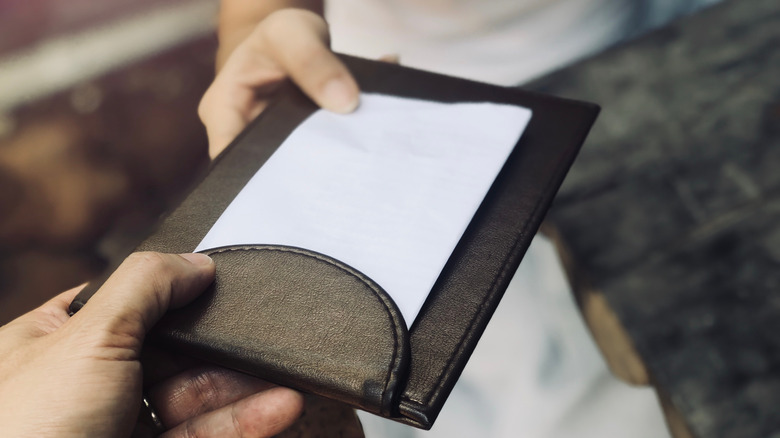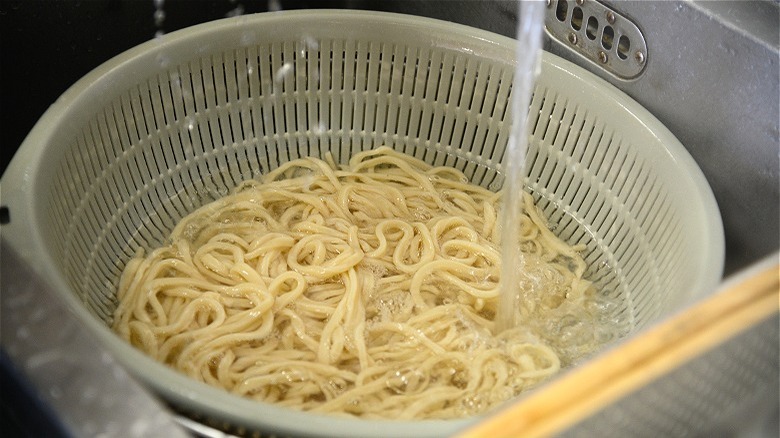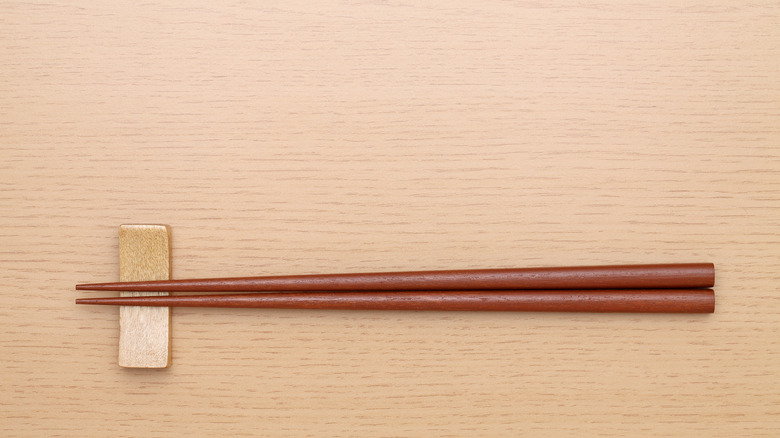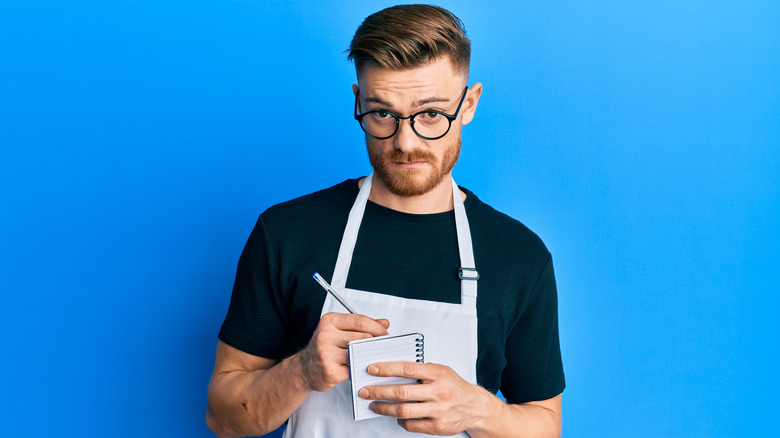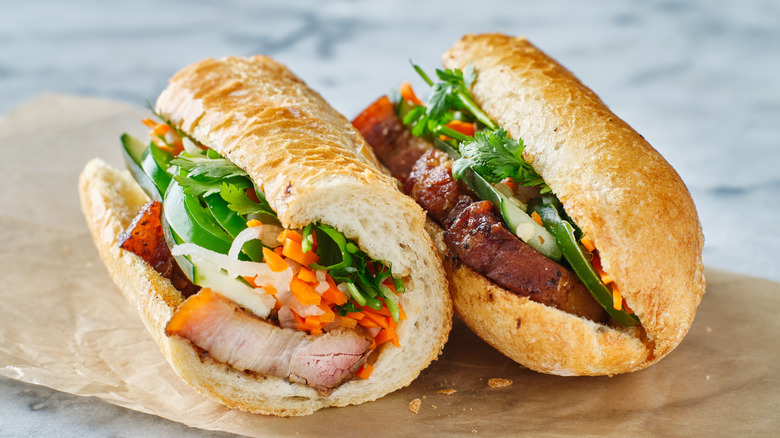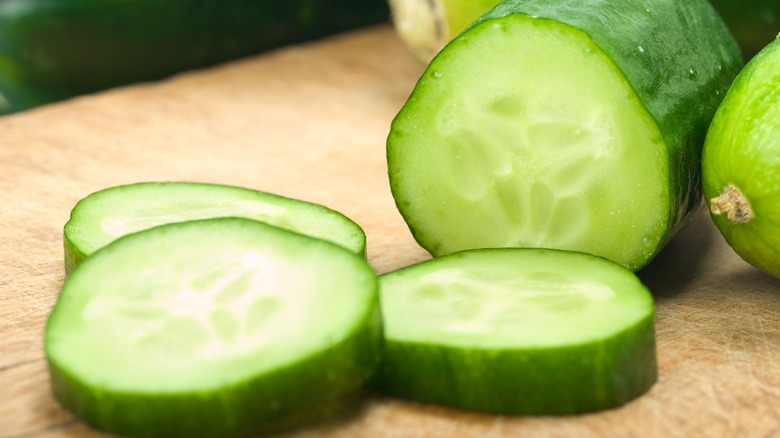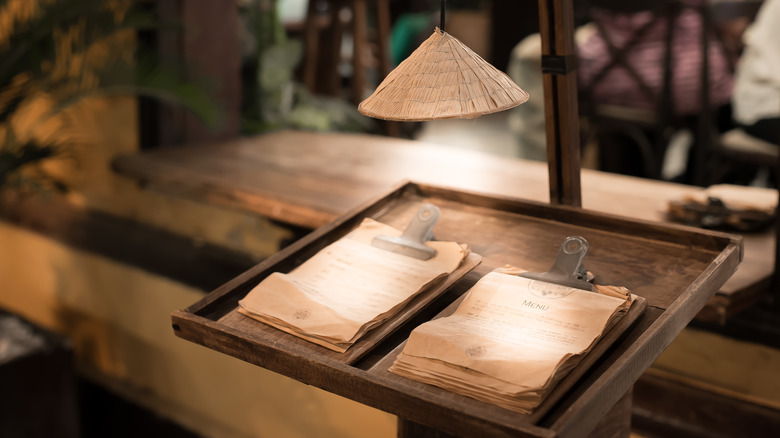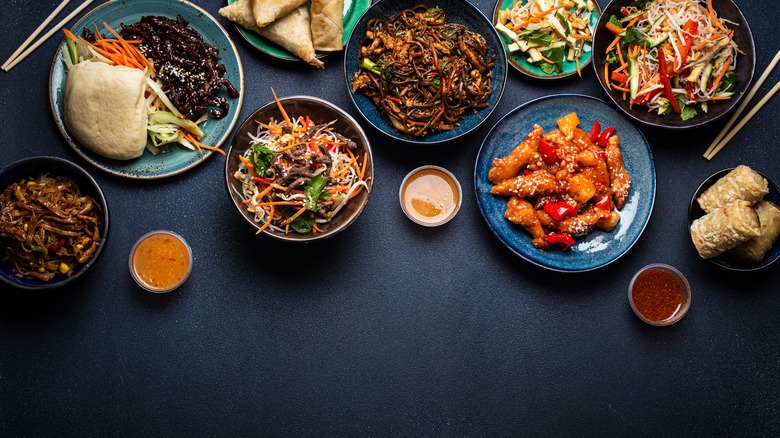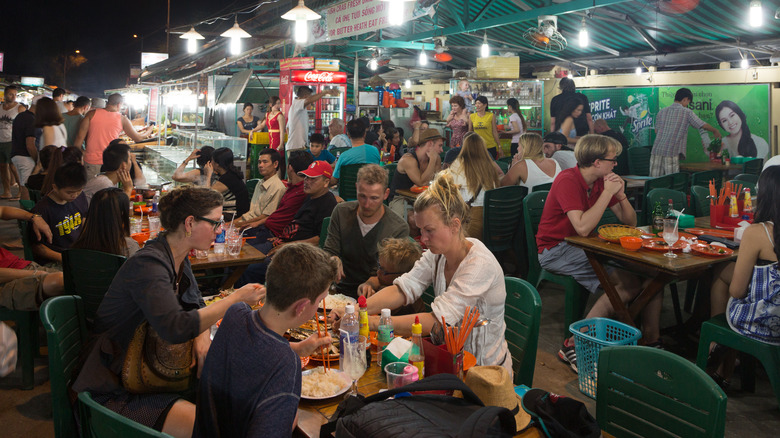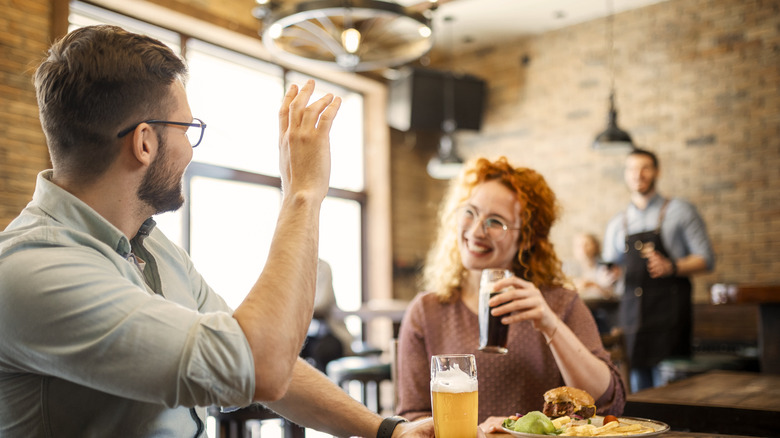14 Red Flags To Look Out For When Eating At A Vietnamese Restaurant
There's nothing quite like Vietnamese food. While Vietnam's national cuisine uses similar ingredients to several other countries in the region, like Thailand and Cambodia, it's in a world of its own. The ultra-fresh flavors of Vietnamese food are a result of generation upon generation of growing and eating food locally, leading to the cuisine having a distinct relationship to the land and its resources. These wholesome ingredients, combined with an unmatched knowledge of flavor, make Vietnamese cuisine nutritious and tasty.
Vietnamese food's incorporation of flavors from other cultures has also made it widely accessible. "Considering Vietnamese cuisine is a vessel that can hold many different influences, it makes the cuisine easy to identify with," chef Tu David Phu explained to The Food Institute. This might be why this cuisine has recently seen a surge in popularity in the United States and across the world.
Whether you're eating Vietnamese cuisine at your local restaurant, or heading to the country itself to enjoy the most authentic dishes imaginable, it's easy to get caught out. Like all cuisines, there's a right way and a wrong way to do Vietnamese food. We've collected some top red flags you should look out for in Vietnamese restaurants here.
1. It only serves pho
Pho – pronounced as "fuh" — is arguably the best-known Vietnamese dish out there. It consists of a combination of rice noodles and meat in a flavorful, light broth. But it's also a meal that's constantly developing. It's said to have been influenced by French colonial rule as well as Chinese cuisine.
This dish is a lot of people's gateway to Vietnamese food. As a result of this, it's a staple of pretty much every Western Vietnamese restaurant. But just because it's delicious, this doesn't mean it's the only type of Vietnamese food you should be eating. If your restaurant is only serving up pho, this is a red flag.
An emphasis on the classic dishes of a specific food culture is no bad thing, but it could indicate that the restaurant isn't invested in delivering the nuances of Vietnamese cuisine. Vietnamese food is diverse, and there are loads of dishes out there to try beyond this famed noodle soup. Clay pot meals like thit kho to, where pork belly is simmered in a sweet fish sauce mixture and served with rice, are a great way to try something new but not super challenging. Want some seafood instead? Try hen xuc banh trang, wok-fried baby clams accompanied with rice crackers. The world is your oyster.
2. The tastes don't feel specific
Let's get something straight, here, folks: Vietnamese food has a flavor profile of its very own. Although it has a relationship with menus in neighboring countries — like China, Thailand, and Cambodia — it's its own thing, and it has the taste to back it up. That's why, if the Vietnamese restaurant you're sitting in has food that tastes a little vague, or a little too much Chinese or Thai food, you should rethink going there again.
Vietnamese food tends to emphasize well-chosen herbs and fresh meats, all tied together with the indistinguishable flavors of fish sauce. The fish sauce provides an umami base note to the cuisine's dishes, in a similar way that soy sauce is used in Chinese and Japanese cooking. "Those basic components of Viet cooking often surprise people who are unfamiliar with it," states author and James Beard Award Winner Andrea Nguyen, per Greatist. "But it's what really makes Viet food like a series of gentle, beautiful rolling hills, as opposed to Thai food, which is lusty and gutsy."
The best way to get familiar with these flavors is to try a range of Vietnamese joints. You'll be able to start to discern what is and what isn't authentic in no time.
3. There's not a lot of sharing going on
The key sign of a top-quality restaurant is when everything just feels right. But that rightness doesn't just extend to the taste of the food you're eating. The most authentic restaurants enable the food culture, customs, and etiquette of its origins to shine through, to make the experience feel just as it would if you were eating in the country that the food is from.
And one key food practice to look out for in Vietnamese restaurants is the sharing of plates. In Vietnam, food is served from a selection of plates on the table, with each diner having their own bowl of rice. Diners will then take portions of food from the central plates, allowing everyone to get a taste of each dish and partake fully in the meal. If, however, the Vietnamese restaurant you've just entered looks like it isn't serving food up sharing-style, it could be a sign that it's not in key with the country's food culture.
When sharing plates in a Vietnamese restaurant, however, there are a few practices that it's good to abide by. Use both hands when passing plates to one another, and try not to eat food straight from the shared plate itself. The best practice is to take a little bit of food at a time and place it on or next to your rice, before eating it from your bowl.
4. The food is served in courses
Most of us enjoy a multi-stage meal now and again, with a starter or soup, main course, and dessert. But somewhere along the line, some folks have started to expect this to be the norm with every meal they have in a restaurant. In Vietnamese eateries, though, this may not entirely be the case. Generally, in Vietnamese cuisine, foods aren't designated into specific courses but are rather served all at once, with the hungry patrons then digging in together.
Therefore, if the Vietnamese restaurant you're mulling over has a system of service that works via starters and mains, it might be a red flag. Naturally, some restaurants aim their business toward clientele with different cultural sensibilities. Of course, some of these businesses seek to offer diners choices in how they eat their food. But if you're going for a Vietnamese meal, don't you want to eat it in the way that it's intended? So skip that starter, and get all of the food in one go.
5. The business brings you the bill
It's an unfortunate fact of life, but after you've enjoyed that delicious meal, you're going to have to pay for it, buddy. But whereas in most restaurants, where you can usually expect your bill to be brought to the table, in Vietnamese places they do things a little differently. Rather than the waiter bringing you your check, you instead may have to get up from the table and head to the front to settle up.
Crucially, though, this isn't because the wait staff have forgotten to bring you your bill, but because it's seen to be a rude practice to do so. It's worth pointing out that this practice might be more common if you're eating in a restaurant in Vietnam, as opposed to one in your own country, where the owners and staff might be adapting to your own local customs. But if you notice bills on the table when you walk in, it might be a sign that where you're about to eat isn't the most authentic Vietnamese restaurant in the world.
6. The pho has wheat noodles in it
You can tell a lot about a Vietnamese restaurant by the way they make their pho. It all starts with the noodles. Pho is typically made with rice noodles, which turn silky and slippery in the broth. Make no mistake: they may be delicate looking, but boy are they filling. This key ingredient distinguishes them from other noodle soups like ramen, which uses wheat-based noodles, or more Western noodle soups like chicken noodle soup. As a bonus, the rice noodles in pho are suitable for folks with celiac disease, thanks to being gluten-free, per Celiac.com.
If the bowl of pho in front of you is made with anything but rice noodles, it's a clear red flag; it's a sign that the restaurant may not be serving up specific, well-made Vietnamese food. Remember, too, that pho has other signature traits that set it apart from other noodle soups. Its broth will generally be clear and fragrant, with whole spices used to impart a complex flavor. Herbs like coriander and basil are also used to give it an additional taste element. The meat in pho will usually be thinly sliced beef, although chicken may also be used.
7. The eatery doesn't give you chopsticks
Look, we get it. Chopsticks can be tricky if you haven't put in the time and effort to master them. But there's no better place to get your practice time in than at a Vietnamese restaurant. This is the main utensil used in Vietnamese cuisine, and so it's pretty typical to find a pair at every table in a Vietnamese joint.
If the restaurant doesn't have chopsticks, though, or doesn't supply them to you readily, be on your guard. This might be a sign that you've just walked into a super-Westernized eatery, that may not only make alterations to their serving utensils but also hold back on the bold flavors of their food. Crucially, though, this isn't a hard and fast rule.
Some Vietnamese restaurants will simply serve you with knives and forks because it could be easier for the unfamiliar to use. This has no bearing on the type of food they'll dish up. As well as this, Vietnamese cuisine doesn't use chopsticks for absolutely everything. For dishes like pho, spoons will also likely be supplied to drink its broth.
8. You feel like you're being rushed
There are few things worse than feeling as though the restaurant you're eating in wants you to leave. If that's happening in the Vietnamese restaurant you're in — not only is it a sign that it might not be the friendliest environment to be eating in — but it could also mean that the restaurant might not be interested in serving up an authentic Vietnamese dining experience.
In Vietnam, dinner is something to be savored. There's little of the eat-and-run attitude that is such a trait in Western culture. Instead, diners tend to take things a little more slowly, giving each dish on the table time and space to be enjoyed fully. This doesn't mean that meals turn into big, bulky affairs, however. The eating speed doesn't reflect the fact that more food is being eaten. The emphasis is on moderate portions made with quality ingredients.
Try not to wolf your food down too quickly when eating in a Vietnamese restaurant. We recommend chewing slowly, too. This is a common practice that is aimed at helping the digestive system, as well as letting food be enjoyed to its fullest. If you feel like things are moving a little too quickly, well, that might just be a red flag.
9. Your bánh mì roll isn't crunchy
Bánh mì is a sandwich with a difference. A direct product of the influence of French culture on Vietnam, this Viet-French invention consists of a sandwich made from crusty white bread, and filled with fresh vegetables and aromatic meat. The sandwich is "a party in your mouth," says cookbook author and Vietnamese food specialist Andrea Nguyen, via NPR. But it's also a food that's highly specific, and if your Vietnamese restaurant isn't nailing the basics, you'd be right to question what else they're getting wrong.
The main thing that sets bánh mì apart from other sandwiches is the bread used, which is a distinctly French-inflected affair, inspired by the baguette. This means that the roll your sandwich comes in should have a crispy, well-baked outside, and soft, pillowy dough in the middle. Soft rolls and slices of sandwich bread need not apply here, folks.
Additionally, the vegetables inside should be super-fresh and crunchy, and there should be a pickled element in there too. It's important to remember, though, that once the fundamentals are established, bánh mì (pronounced "bun mee") sandwiches can contain anything. Nguyen points out that French pâté has even been used in some recipes.
10. The vegetables are uncooked
There are some situations in Vietnamese cuisine where fresh vegetables are required, like salads or bánh mì. But if you're eating in a Vietnamese restaurant within Vietnam itself, it's always wise to be on your guard about how vegetables are prepared generally. It's advisable that, if you're eating in a local restaurant, you should avoid uncooked vegetables.
The simple reason for this is the same reason you should try and be on your guard about food safety pretty much everywhere you travel in the world: You're more likely to get sick. Going to any new country means that you're entering into a new world of foodborne bacteria, per Travelex Insurance. And while your stomach may be accustomed to the potential pathogens in your own country, it may not be in the country you're visiting, like Vietnam. As such, any restaurant that serves up its vegetables uncooked to foreign diners may be somewhat playing with fire. The good news is, though, that fresh herbs will generally be safer to consume.
11. The menu is wildly extensive
Let's say you're looking for a new Vietnamese restaurant, and one menu caught your eye. As you scroll through it on your phone, it just keeps going, and going, and going. "Wow," you think, "the chef here must be amazing if they can make all of these dishes!" With that, you hastily call the number and book a table.
This is one of the worst things you can do. Although it may surprise you, a long menu at a Vietnamese restaurant is not an indicator of quality, but rather a sign that the business may be spreading itself too thin. "Any restaurant with a large menu that's more than two pages is often over-ambitious," says author Andrea Nguyen via Greatist.
Nguyen instead suggests looking for a menu that keeps things modest. Ideally, the restaurant you're looking at should have a contained, but clearly-focused list of dishes. This may indicate that the chef has spent time and effort perfecting these meals, instead of trying to offer loads of options, but at the expense of quality. If you're still in doubt about what to order, Nguyen advises letting the restaurant decide for you and going for their specialty.
12. There are dishes from other cuisines
We understand that everyone likes to have a choice. Sometimes, despite having a hankering for Vietnamese food all day, when you actually sit down at the table, you may be craving something else entirely. But, if the restaurant you're eating in caters to that urge — and indeed offers a host of cuisines other than Vietnamese — it's a bright-red flag that means the food might not taste great.
This is a particularly bad sign if the restaurant you're in is in Vietnam itself. When restaurants in a country you're visiting on holiday offer a variety of dishes from different food cultures, it essentially means they're trying to advertise to the largest cross-section of people possible. In other words, you've ended up in a tourist trap. Don't get us wrong, some tourist traps can have pretty great food. But in reality, what you may be getting is a watered-down version of the traditional cuisine and dining experience.
To combat this, look for restaurants that are specifically Vietnamese. There's no harm, of course, in searching for a Vietnamese restaurant that has an English-language menu, especially if you don't speak the language. But your best bet is always to follow the locals, and see where they're eating, to get the best grub.
13. The restaurant is busy at odd times
Standard eating times for meals can vary widely around the world. Some people in Northern European countries like Norway and Finland, for example, have their dinner as early as 4 p.m. But in other countries like Spain, folks may eat dinner as late as 10:30 pm. So when a restaurant that specializes in a national cuisine is busy at a time that aligns with their citizens' standard eating time, that's a good sign that it's popular with the locals. That usually means it has good food.
As such, when choosing a Vietnamese restaurant, a green flag is that it's busy during the standard times that Vietnamese people tend to eat. A red flag, conversely, is that it's busy at other, slightly more unusual times. Vietnamese people tend to have an earlier lunch, between 12 and 1 p.m., and dinner tends to fall between 6 and 8 p.m. If the restaurant is busy outside of these periods, or quiet within these times, it could be a sign that it's a place not worth eating at. But if you're struggling to get a table in these times? It's likely a joint that serves up some delicious eats.
14. You feel like you can't ask for help
For people who aren't familiar with Vietnamese cuisine, things can be a little confusing. It's perfectly reasonable to ask for advice or assistance on what to order. Feel free to consult the wait staff.
A key red flag in any Vietnamese place is if you get a sense that asking for help wouldn't be okay. "Don't be afraid to ask people for help if you don't understand something. Vietnamese people are proud of their cuisine and you'll make quick friends while learning something new," explains food author Andrea Nguyen, per Greatist. By this rule of thumb, if you're in a place where something feels off, and things are a little unfriendly, it could be a sign that you won't want to eat there.
Above all, you shouldn't be intimidated by Vietnamese cuisine, says Nguyen. "Enjoy Viet food the way you decide you like to. There are few rules — depending on the dish, you may eat it with chopsticks, spoons, forks, or your hands," she states. So dive in, chow down, and enjoy!
